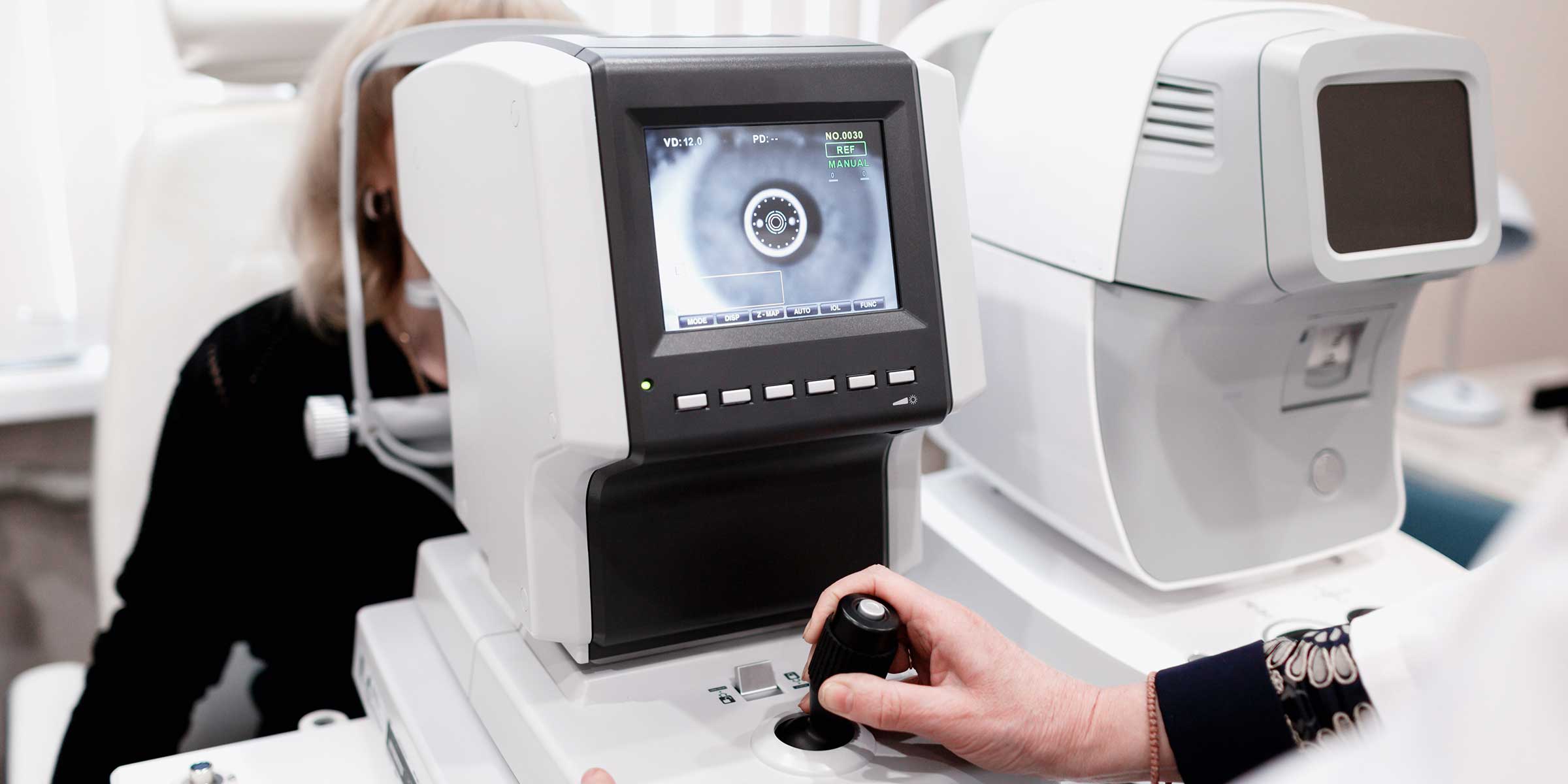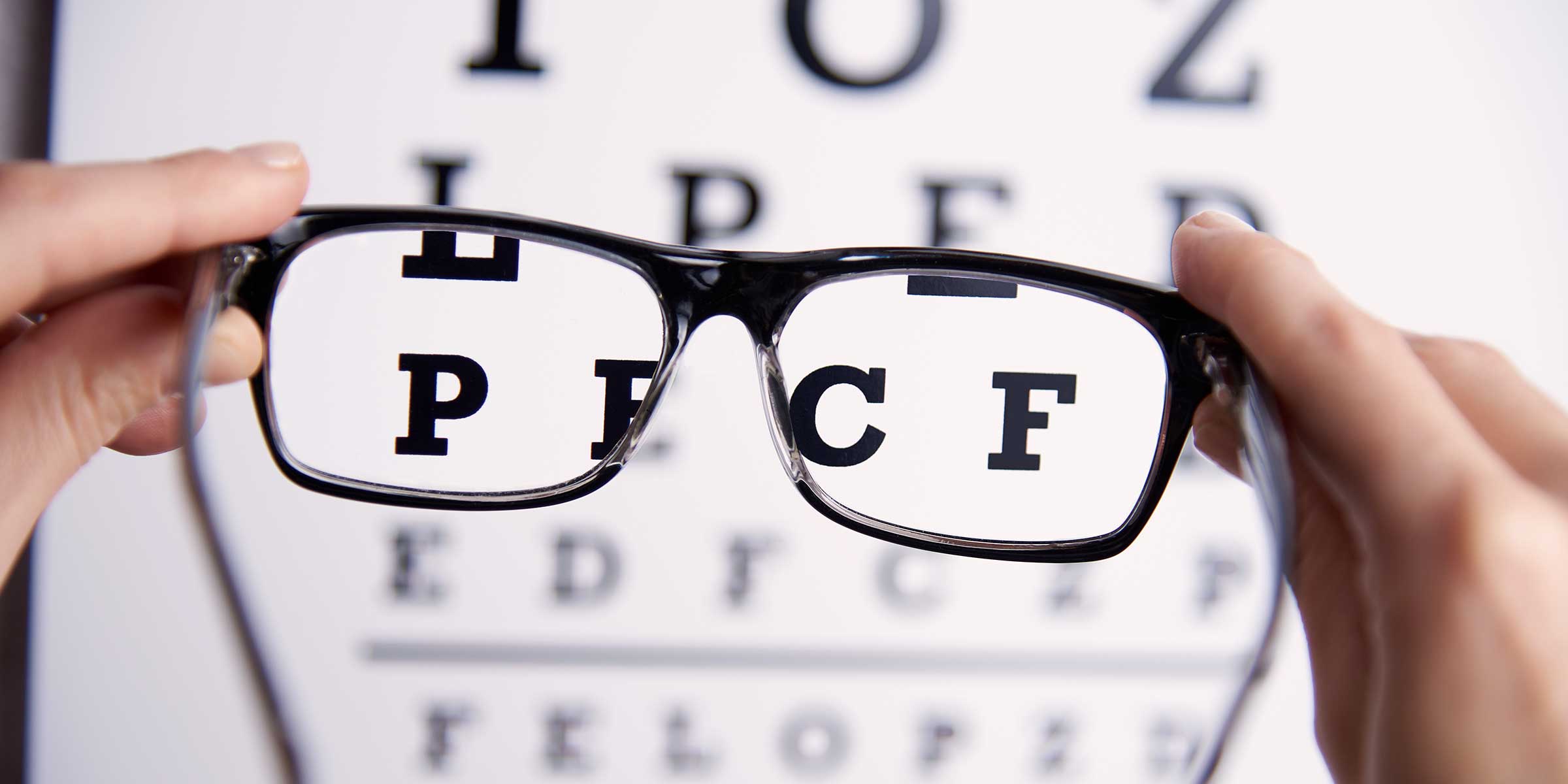Search based on the size of your current glasses
- Shop by shape
- Shop by colour
- Shop by size


Whether you keep up to date with your biennial eye test or haven’t had your eyes checked since you were in school, having an understanding of what goes on during your test is important. So, if you’ve ever wondered what happens during your eye test and why certain things happen, we talked to one of our opticians about all the ins and outs of eye tests. They explained everything including what’ll happen, what machines/instruments are used and how your prescription is calculated.
The eye examination involves so much more than determining the right prescription for your glasses. A thorough eye exam can detect signs of cataract, glaucoma, diabetes, high blood pressure, and many other conditions.
For most people it is recommended to be tested every two years, though if you have a condition that needs closer monitoring, such as diabetes or glaucoma, this is likely to be every year or sooner. Your optometrist will advise if they recommend you’re seen any sooner. There are lots of different tests your optometrist can perform depending on your personal needs, but a thorough eye exam will usually consist of the following elements for most people:
Simple pre-screening tests are often undertaken by a trained optical assistant before you go in for your eye exam. These may include the following:
This is especially important if the optician you’re visiting hasn’t given you glasses before, as it gives the optometrist a good indication of how your prescription has changed from your last eye exam. Your glasses will be checked on a ‘focimeter’ which reads the prescription in your glasses very accurately.
This special machine gives an approximation of the prescription you will need. In this test you’ll be asked to look into the machine and focus on an image. The image will appear larger and smaller. As your eyes focus on the changing image the Auto-refractor estimates your prescription. Auto-refractors are increasingly accurate, but cannot be relied on to fully determine your prescription – only a qualified optometrist or suitably qualified doctor can do that.
Any visual field loss can be a sign of glaucoma or macular degeneration, so this is a very important test and will accurately plot any blind spots in your visual field. You’ll be asked to look into a bowl and focus on a central point. Next you’ll be shown a series of lights of increasing brightness. These lights will be situated all around the bowl, and when you see any of them you press a button. The optical assistant might ask you where you saw the light, just in case you try to cheat it!
This is another important test to determine the presence of glaucoma. The machine that measures this is called a Non-Contact Tonometer. It puffs a jet of air at the front surface of the eye and calculates the resistance of the front of the eye to the puff of air, and converts this into a measure of the pressure inside your eye. It’s quite painless but might make you jump!


Before performing a number of tests on your eyes, the optometrist will ask you a series of questions about: your general health, any medication you might be on, if there is any family history of eye conditions such as glaucoma, or any vision problems you may be experiencing. They’ll often make a note of any hobbies and interests as well as your occupation.
The optometrist will use a retinoscope to shine a light into your eyes to view the reflection or reflex of the retina. The optometrist will observe this reflex, then add lenses to neutralise it. This test helps determine the amount of correction you’ll need, and is especially useful when testing people who are unable to have a full eye exam, such as very small children.
The optometrist will use a small instrument, about the size of a torch, to look through your pupil and observe the back of your eye, known as the fundus. The ophthalmoscope can magnify the image up to 15 times and is very important to check the health of the retina, optic disc, and the vitreous humour. It also monitors eye conditions like diabetes and glaucoma.
If the optometrist can’t see a detailed enough view of the back of your eye, they may put some drops in your eyes to dilate the pupil to have a better view. They may also use a special microscope called a slit lamp for a more detailed illuminated examination of the fundus. Some practices will offer detailed digital photography that gives a very wide field of vision of the back of the eye. This offers peace of mind, but can cost extra so we recommend you ask your optometrist if you’d benefit from it.
This test checks how the eye muscles work together. The optometrist will ask you to fixate on a spot on the wall of the testing room and will then observe what happens to your eyes when one of them is covered, then uncovered. This is repeated on the other eye. The optometrist is looking to see if either eye moves when the other is covered or uncovered. If so it may indicate a squint, otherwise known as a strabismus.
To see how the eyes track objects the optometrist will ask you to follow the track of a slow moving object, for example, the top of a pen, with your eyes only. This is repeated at a faster speed to see how well the eyes track fast moving objects. The optometrist might ask you to look from one object to another, several times. Problems with ocular motility can lead to eye strain and difficulty with reading.
This is what most people would understand by an eye exam, and involves the optometrist first asking you to look at the sight test chart and read the smallest line you can without your glasses so that they can determine your standard of unaided vision. They will also ask you to read the smallest line of print that you can read unaided at 40cms. The standard of unaided vision, and indeed the standard of corrected vision, is represented as a fraction, such as 6/12, 6/9, or 6/5.
The top number refers to the distance in metres you are away from the chart. This is usually 3m, which is the set distance from the consulting room chair to the mirror you look at to read the test chart. Without the use of a mirror consulting rooms would all need to be a minimum of 6m long. 6m is 20 feet, and you’ll probably be familiar with the phrase 20/20 vision. In Europe this equates to 6/6 vision. The bottom number relates to the ‘size’ of the letter line you can read. The lower the bottom number, the smaller the letters on the chart you can read.
It’s called subjective refraction because the optometrist will ask you a series of questions like: “are the letters clearer with the first lens, or the second one, or are they both the same”, and your responses will be used to fine-tune the prescription results. Answer honestly – your answers won’t be marked!


The first part of the refraction is to determine the ‘best vision sphere’. The remainder of the refraction is based around this. Usually the right eye is tested first, then the left – your right eye is on the left of the optometrist, and like reading we work from left to right. This is why your right eye prescription always comes before the left.
Using the estimated results from the auto-refractor and retinoscopy, the optometrist will put spherical lenses in front of your eyes and ask you to read the smallest line on the test chart. Depending on how small the letters you can read are, the power of the lens they try next could change. The best vision sphere is the most positive, least negative power consistent with the smallest line of letters you can read.
Once the best vision sphere has been established, the optometrist will check if there is any astigmatism present by using a ‘cross cylinder’. They will ask questions such as “which lens choice is clearer; choice one, or choice two.” They will then repeat this procedure a number of times to refine the correction based on your answers.
Finally, once the level of astigmatism has been established for each eye, the optometrist will balance the prescription binocularly. Until now each eye has been tested individually, but as the eyes are designed to work together it’s important the correction is fine-tuned and balanced across both eyes.
When the long distance prescription has been finalised the optometrist will pass you a special book with different sizes of print to test your near vision. They will ask you to read the smallest line of print that you can at 40cms. If you can’t read the smallest line clearly they will add magnifying lenses on top of your distance correction until you can see the smallest line of print. The power of the magnifying lens that enables you to read the smallest line at 40cms is your Reading Addition.
Once this is done the optometrist should give you a copy of your prescription. If they don’t provide this you should ask for a copy. It’s your prescription and you can take it to any optician or online supplier to order your glasses if you need any.
There are no figures on the glasses or lenses that will tell you what your prescription is, and no optician will be able to tell just by looking through your lenses. However, there are special machines called focimeter that can read your prescription from the lenses.
No, you don't have to buy glasses after your test. However, if your prescription has changed, we recommend that you do, although you don’t have to buy glasses from the same optician who tested you. The prescription that is given to you after your eye test should contain all the information needed for any optician – such as Glasses Direct – to make glasses for you. If the optician who tested you does not automatically give you a copy of the prescription, remember to ask for it - they are legally obliged to supply one.